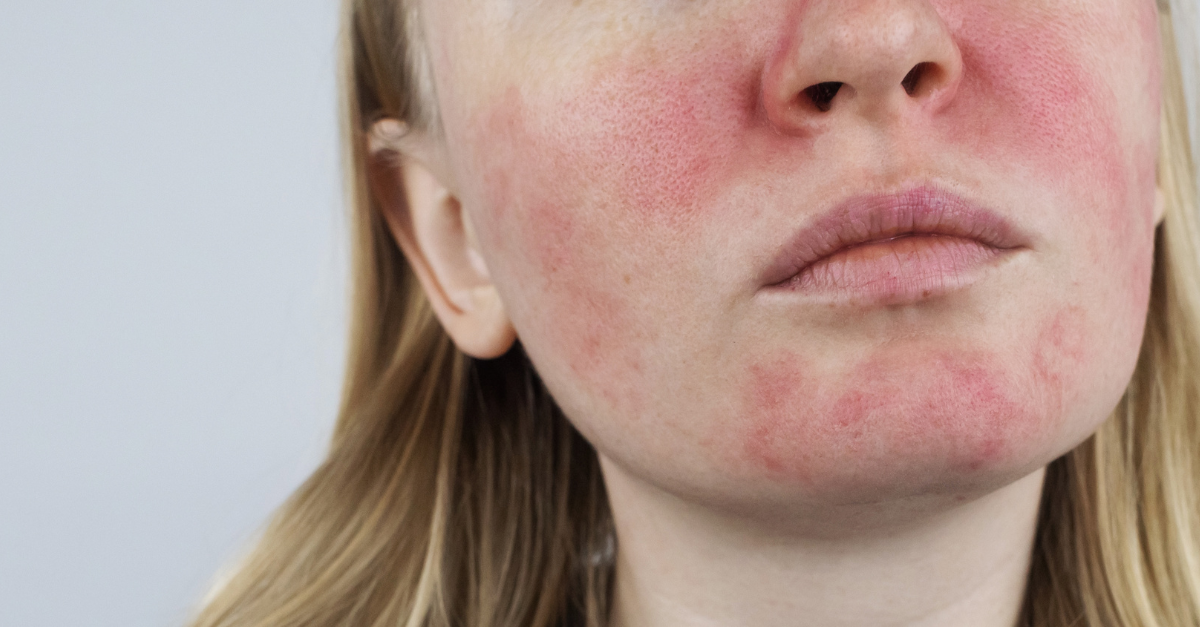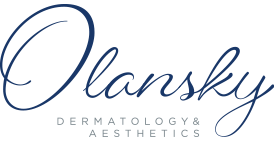Although chronic, rosacea (pronounced “roh-ZAY-sha”) is a treatable condition that primarily affects the middle area of your face, including your cheeks and nose. It is often experienced as flare-ups that then can go into remission.
According to the National Rosacea Society, rosacea may develop in many ways and at any age. They explain: “Patient surveys indicate that it typically begins any time after age 30 as flushing or redness on the cheeks, nose, chin or forehead that may come and go.”
Rosacea is a widespread facial condition estimated to affect more than 16 million Americans — including celebrity Cynthia Nixon. For Rosacea Awareness Month, the experts at Olansky Dermatology have pulled together some facts and resources about the condition for you.
What Are the Symptoms of Rosacea?
There are several ways in which rosacea manifests itself:
- Erythematotelangiectatic Rosacea
Redness & flushing, visible blood vessels - Papulopustular Rosacea
Redness, bumps and pimples, visible blood vessels - Ocular Rosacea
Eye Irritation, itching, redness, grittiness, occasional cysts - Phymatous Rosacea:
Raised patches of skin (plaques)
Skin thickening and enlargement (specifically around the nose, primarily in men)
Secondary symptoms of each of these types can include dryness, burning or stinging, and sensitivity in the area.
What Are the Causes of Rosacea?
The precise cause of rosacea is unknown, but the Mayo Clinic indicates the condition could be caused due to a combination of hereditary and environmental influences. Be assured rosacea is not caused by poor hygiene.
A number of factors can trigger flare-ups, including:
- Hot drinks and spicy foods
- Red wine and other alcoholic beverages
- Temperature extremes
- Sunlight or wind
- Strong emotions
- Heavy exercise
- Drugs that dilate blood vessels, including some blood pressure medications
- Various cosmetic products
Anyone can develop rosacea. But you may be more likely to encounter it if you:
- Are female
- Have light skin, particularly if it has been damaged by the sun
- Are over age 30
- Smoke
- Have a family history of rosacea
How Can Rosacea Be Treated?
There is currently no absolute cure for rosacea, but understanding its signs and symptoms can help you control it effectively.
Adequate treatment depends highly upon the type you have. Consultation with your dermatologist is strongly encouraged, but here are some of the general approaches they may recommend.
Creams and Gels
The experts at Olansky Dermatology & Aesthetics may suggest several options for a prescription cream or gel that may be recommended for use on your face once or twice a day.
These include:
- Azelaic acid
- Brimonidine
- Clindamycin
- Erythromycin
- Ivermectin
- Metronidazole
- Sodium sulfacetamide and sulfur
- In hard-to-treat cases, tretinoin (Avita, Retin-A), may also be recommended.
As these treatments can cause some side effects, and may not be suitable for women who are pregnant or may become pregnant, be sure to talk to your dermatologist about whether they are right for you.
Surgery
Surgery is mostly recommended for phymatous rosacea, when the thickening of the skin (usually around the nose) interferes with a patient’s confidence, overall health, or lifestyle.
When both the patient and dermatologist deem surgery as an optimal treatment, the National Rosacea Society lists a wide range of options, including cryosurgery, radiofrequency ablation, and electrosurgery tangential excision combined with scissor sculpturing and skin grafting. In some cases, a surgical laser may be used to recontour the nose — a process that is sometimes followed by further dermabrasion.
Regardless of the status of your rosacea symptoms (or even if you only suspect you may have it), we want to talk to you. Our full-service dermatology centers offer customized treatments tailored to each patient’s unique needs. Schedule an appointment online or call (404) 355-5484.


